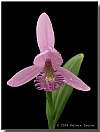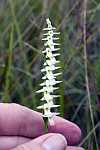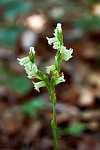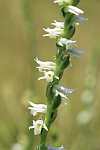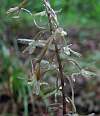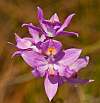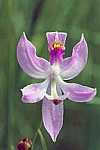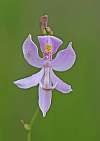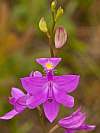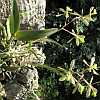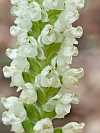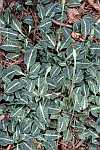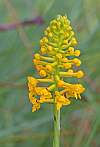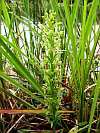Orchid Habitat Loss
The
Green
Swamp, North Carolina
PhotograhersM Fields, Jim Fowler, Rich Leighton, Larry R Lynch, David Kelly, Mett Jr, David McAdoo, Perkins4, Skip Pudney and Kelvin Taylor
text by Mark Sullivan

Green Swamp savanna with Gentiana autumnalis "Pine Barrens Gentiana", © Jim Fowler
In the southeast corner of North Carolina there is a habitat with high biodiversity and unique species called the Green Swamp. The Green
 Swamp
is one of the best remaining examples of longleaf pine savannas, bay
forests and
pocosins ecosystems left. The World Wildlife Fund has identified the
Green Swamp as one of the top ten ecoregions in North America for the
number of species of plants and animals. This pine savannah is home to
14 carnivorous plants and 18 species of orchids. Unusual animals found
in the swamp include the endangered red-cockaded woodpecker (which
nests in the trunks of live longleaf pines), Henslow’s sparrow,
Bachman’s sparrow, Hessel’s hairstreak butterfly, and the American
alligator.
Swamp
is one of the best remaining examples of longleaf pine savannas, bay
forests and
pocosins ecosystems left. The World Wildlife Fund has identified the
Green Swamp as one of the top ten ecoregions in North America for the
number of species of plants and animals. This pine savannah is home to
14 carnivorous plants and 18 species of orchids. Unusual animals found
in the swamp include the endangered red-cockaded woodpecker (which
nests in the trunks of live longleaf pines), Henslow’s sparrow,
Bachman’s sparrow, Hessel’s hairstreak butterfly, and the American
alligator.Platanthera ciliaris closeup © Skip Pudney
The History and the Habitat of the Green Swamp
In 1977, the Federal Paper Board donated 13,850 acres of land to the N.C. Nature Conservancy and additional acres in the late 1980’s. In 2004 The Nature Conservancy bought additional acres and then at a later date transferred them to the North Carolina Wildlife Resource Commission. This area is marked by the large red outline towards the middle of the map below. The Green Swamp Preserve now covers 15,907 acres or 5.6 % of the original Green Swamp. The Green Swamp originally covered 140 square miles (36259.83 hectares /89599.64 acres) in Brunswick and Columbus counties. The major habitat components of the Green Swamp are water, pocosins, sandy peat soil, longleaf pines, wiregrass and fire.

The yellow lines are a rough outline of the original Green Swamp area based on the Brunswick County Green Swamp Area Map. The red lines are current protected areas within the Green Swamp. Click on the picture for a larger picture. You can also go down to the bottom of this article to explore the area through an interactive Google Map.

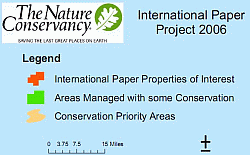 This map shows areas under some conservation protection and areas the
Nature Conservancy is interested in protecting.
This map shows areas under some conservation protection and areas the
Nature Conservancy is interested in protecting.While the Green Swamp actually has some swamp in the common sense of the word, most of the Green Swamp, that is natural, is pocosins (about 85%) and longleaf pine savannas. Pocosin is an Algonquian Indian word meaning swamp on a hill. About 13,000 of the Green Swamp Preserve's 16,000 acres are pocosin, so the word "swamp" in the Green Swamp is appropriate. Pocosins are wetlands that have developed an organic soil layer on top of sand and rise above the surrounding topography. The organic soil layer is a waterlogged, nutrient poor, acidic mixture of peat, sand and charcoal from periodic natural fires occurring in late spring or summer. Pocosins are ombrotrophic meaning most of their water comes from rain as they are higher and isolated from large streams. They do have a hydrologic surface connection to surrounding estuaries and are connected to the region’s water supply (Richardson C. J., 2003). Thus pollutants can affect the water quality and salinity of pocosins. There is no standing surface water in pocosins, but the water table is just below the surface. Due to poor drainage and the sponge like organic material, pocosins can remain wet most of the year depending on their size. Pocosins can be as large as several thousand acres. They slowly release water into the surrounding land. Because of the available water, pocosins become thick with vegetation primarily gall berry (Illex glabra), titi trees (Cyrilla racemiflora) and Sweetbay magnolia (Magnolia virginiana). The periodic fires open them up to a greater diversity of plant life like orchids. The edges of the pocosins and the Longleaf pine/ wiregrass savannas provide an opportunity for the growth of orchids and other interesting plants. Over 51% of the forested palustrine wetlands in North Carolina have been disturbed and about 33% of pocosins have been destroyed (Richardson C. J., 2003).

Green Swamp Savanna, Pitcher Plants and Calopogon tuberosus © Skip Pudney

Longleaf pine savannas used to occupy 55 million acres between Texas and Virginia. Now only 2 percent of these savannas remain (Noss, 1989). The longleaf pine is slow to mature and is capable of living over 400 years (Platt and Rathburn (1993). Longleaf pines must mature to 80 years old to produce substantial amounts of seed. Seedlings need fire followed by moist years in order to establish them. Longleaf pines do not grow in pocosins, but in a mineral soil.
Longleaf pine seedling are able to survive periodic fires. © Skip Pudney
Wiregrass or pineland threeawn (Aristida stricta) is a valuable food and cover for many mammals, reptiles, and birds. It is fast growing and also benefits from periodic fires to stimulate flower and seed production.

Long Leaf pine Savanna and Wiregrass © Skip Pudney
Periodic fires constitute a very important part of this ecology and are integral in the survival of many plants including orchids. Fire clears out the underbrush and reduces the ground competition for space, light, water, and nutrients. Fire reduces invasive plants that are not adapted to fire cycle of the longleaf pine savanna. Orchid roots, rhizomes and corms are protected from periodic fires for several reasons. The fires normally happen in the late summer dry period after the orchid’s seasonal growth is completed and the upper part of the plant is drying up. The roots, rhizomes, and corms are protected by the airy, moist “soil” which insulates them from the heat. The periodic fires are not hot enough for the heat to damage the root areas.

A planned controlled fire in the Green Swamp 2009. © Skip Pudney

After the fire burns and is put out. © Skip Pudney

Three months after the controlled burn © Kelvin Taylor
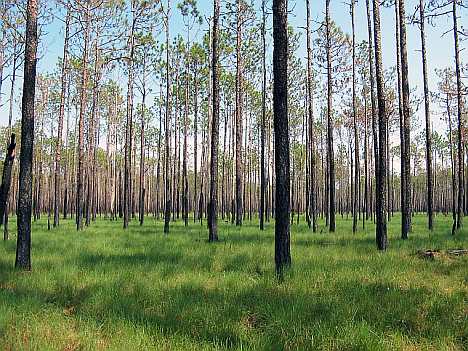
Continued recovery after the controlled burn © David McAdoo

One year after the burn © David McAdoo
All the plants in this ecosystem have adapted to periodic fires. Many need fire for reproduction. Adaptations like the bark on the Longleaf pine insulate them from fires. Wiregrass grows back quickly.
The role fire plays with terrestrial orchids is not well understood but terrestrial orchids do benefit. They often flower in greater numbers in the next growing season after a fire occurs. The burning of other competitive plants allows for more light, space and water. The chemical effects of ash
 releases
phosphate to the soil and roots which may
trigger flowering. Ethylene gas released by the fire may invigorate
orchids to flower. Fires could also affect the abundance of
pollinators or the mycorrhiza so that the orchids
synchronize the
release of seeds with mycorrhiza growth in a regenerating ecosystem.
releases
phosphate to the soil and roots which may
trigger flowering. Ethylene gas released by the fire may invigorate
orchids to flower. Fires could also affect the abundance of
pollinators or the mycorrhiza so that the orchids
synchronize the
release of seeds with mycorrhiza growth in a regenerating ecosystem. Pogonia ophioglossoides © Kelvin Taylor
The Orchids
In general orchids are edge or transition ecosystem plants. This is very true of the orchids that are found in the Green Swamp. The Green Swamp provides several ecotones such as pine savanna pocked with pocosins. Nutrient poor substrate and periodic fires create other edges where only certain plants can live. Edge or transition areas are very dynamic areas for biodiversity. An abundance of 50 species per square meter (McIver 1981, Walker and Peet 1983) has been found living in the transitional areas between the pocosins and the longleaf pine savannas. This richness in species biodiversity is one of the highest in North America. Without protection of this habitat, we would lose a great biodiversity jewel. Some orchids found in the Green Swamps are: Calopogon barbatus (bearded grass-pink), Calopogon multiflorus (Many Flower Grass Pink), Calopogon tuberosus (Common Grass-Pink), Calopogon pallidus (Pale Grass-Pink), Cleistes bifaria (Smaller Rosebud Orchid), Cleistes divaricata (spreading pogonia), Epidendrum magnoliae (Green Fly Orchid), Goodyera pubescens (Downy Rattlesnake Plantain), Gymnadeniopsis integra /Platanthera integra (Yellow Fringeless Orchid), Habenaria repens (Water-Spider Orchid), Listera australis (Southern Twayblade), Platanthera blephariglottis (White Fringed Orchid)/ Platanthera conspicua (Southern White Fringed Orchid), Platanthera ciliaris (Yellow Fringed Orchid), Platanthera cristata (Orange Crested Orchid), Platanthera flava var. flava (Southern Tubercle Orchid), Platanthera nivea (Snowy Orchid), Pogonia ophioglossoides (Rose Pogonia or Snakemouth), Spiranthes cernua (Nodding Ladies’ tresses), Spiranthes laciniata (Lace-lip
 ladies’
tresses),
Spiranthes
longilabris (Giant Spiral Orchid), Spiranthes odorata
(Sweet
Scent
Ladies’ tresses
), Spiranthes
praecox (Giant Ladies’ tresses), Spiranthes sylvatica
(Woodland Ladies’ tresses), Spiranthes
vernalis
(Spring Ladies’ tresses), and Tipularia
discolor (crane-fly orchid). Historical or undated
occurrences of orchids in which there is some doubt
of its continued existence:
Malaxis
spicata (Florida
Adder’s-mouth), Ponthieva
racemosa (Hairy Shadow Witch), and Spiranthes
floridana (Florida
Ladies’ tresses).
ladies’
tresses),
Spiranthes
longilabris (Giant Spiral Orchid), Spiranthes odorata
(Sweet
Scent
Ladies’ tresses
), Spiranthes
praecox (Giant Ladies’ tresses), Spiranthes sylvatica
(Woodland Ladies’ tresses), Spiranthes
vernalis
(Spring Ladies’ tresses), and Tipularia
discolor (crane-fly orchid). Historical or undated
occurrences of orchids in which there is some doubt
of its continued existence:
Malaxis
spicata (Florida
Adder’s-mouth), Ponthieva
racemosa (Hairy Shadow Witch), and Spiranthes
floridana (Florida
Ladies’ tresses).Gymnadeniopsis integra © Jim Fowler
The Threats
Many of the threats that face the Green Swamp ecosystem are the same threats that face other habitats around the world. Loss of habitat due to housing development, logging and farmland has greatly reduced the Green Swamp. Large commercial landfills have been proposed for the Green Swamps in the past. You can see current habitat loss and land use of the Green Swamps in the maps at the beginning of this article.

Clear cut logging in the Green Swamp. Canals are cut to drain water from the pocosins for the loblolly pine plantations. Picture from - INTERNATIONAL PAPER IN THE SOUTHERN U.S. A Case Study of an SFI Member Company’s Destructive Practices in North Carolina
In 1795, the State of North Carolina gave a huge land grant to three men for cutting the timber and mining peat. Intensive commercial logging in the Green Swamp started around 1904. As commercial logging developed, a large portion of the Green Swamp and Waccamaw River watershed, which abuts the Green Swamp, were converted from longleaf pine savannas and pocosin wetlands to loblolly pine plantations. Today, Loblolly pine (Pinus taeda) is the most important commercial timber in the southeastern United States and accounts for over 50% of the standing pine in the southeast. Although it is a North American native tree, it can be considered invasive in environments where it was not originally found. It is an easily-seeded, fast-growing member of the yellow pine group and can grow in a variety of soils. Therefore it is grown instead of longleaf pine for commercial timber production. Logging continues in and around the Green Swamp today.

Clear cutting in the Green Swamp-
INTERNATIONAL PAPER IN THE SOUTHERN U.S. A Case Study of an SFI Member Company’s Destructive Practices in North Carolina
Land loss due to housing development, logging, and farming is only the beginning of the story of habitat degradation and loss even to the parts of the Green Swamp that are protected today. Along with this development, roads are built that can break up area water flow and the building of ditches and canals to drain the swamp and control water flow. The use of water for drinking, agriculture and manufacturing can reduce an area’s water table. As shown by Curtis Richardson, pocosins are not as isolated from the overall region’s water system as once thought. In the past, there have been political attempts to designate the Green Swamp pocosins as “not wetlands”. During the second Bush administration there was an attempt to change the Clean Water Act to exclude “wetlands” isolated and not immediately adjacent to estuaries. Wetlands are now seen by many as an important cleanser and storage area for fresh water. They are as important for developed human areas as they are for the natural ecosystem.

This map shows roads and canals that cut through the Green Swamp draining the swamp and reducing water flow. We often do not realize how much we change and develop an area over the years.
Runoff of pesticides and fertilizers from farming and runoff from storm drains in neighborhoods affect the water quality, the nutrient availability, and the acidity in wetlands. Monoculture of tree farms and other agricultural crops limit biodiversity that surrounds any protected habitat. The fragmentation of land creates habitat islands with limited genetic and species diversity. The size of the habitat island and its distance to other habitat islands will affect whether a natural ecosystem is sustainable.
Fire suppression was practiced for years throughout North America. Authorities believed that wildfires in a natural ecosystem would spread into the developed areas and responded by putting the fires out. This had the unintended consequence of letting dead wood accumulate. When a fire ignites in a forest with built up debris, it becomes very hot and can cause widespread damage to both natural areas and developed areas. Periodic fires are a natural protection for many ecosystems. These low intensity fires burn dead wood, forest debris and prevent fire-sensitive hardwoods from growing. When hardwoods grow in an open longleaf pine savanna, they close the forest canopy and block the light which adversely effects the growth of orchids and longleaf pine seedlings. This is how a forest transitions from an open pine forest to a hardwood forest. The low intensity fires are an integral part of the successful growth of the orchids and the habitats found in the Green Swamp.
The Green Swamp is a shell of its former self. The area will continue to be stressed as area population grows. The need for fresh water and agricultural products like food and timber will grow. The natural habitat of the Green Swamp has a toe hold in Lake Waccamaw State Park and the Green Swamp Preserve. Hopefully these conservation efforts will be expanded enough to preserve a viable Green Swamp ecosystem into the future.
References
Frankenberg, D. (2000). Wetlands of the coastal plains. Retrieved June 13, 2010, from LEARN North Carolina: https://www.learnnc.org/lp/editions/cede_wetlands/509
Garland, B. (2009). Connection to the Past. Outdoor Alabama,14-17.
Retrieved June 30, 2010
McIver, H. (1981). Green Swamp Nature Preserve, Brunswick County, North Carolina. Durham: Report for The Nature Conservancy, North Carolina Chapter.
Noss, R. F. (1989). Longleaf pine and wiregrass: keystone components of an endangered Ecosystem. Natural Areas Journal 9(4) [12033] , 211-213.
Platt W.J. and Rathburn, S. (1993). Dynamics of an old-growth longleaf pine polutation. Tall Timber Fire Ecology Conference 18, (pp. 275-297).
Richardson, C. J. (1983). Pocosins: Vanishing Wastelands or Valuable Wetlands? BioScience, Vol. 33, No.10 , 626-633.
(2003). Pocosins: Hydrologically isolated or integrated wetlands on the landscape? Wetlands 23(3) , 563-576.
Rome, A. (1988). Vegetation Variation in a Pine-Wiregrass Savanna in the Green Swamp, North Carolina. Castanea, Vol. 53, No. 2 , 122-131.
Schafale, M. (2005). Atlantic Coastal Plain Northern Wet Longleaf Pine Savanna and Flatwoods Ecological Integrity Assessment. Raleigh: North Carolina Natural Heritage Program, Office of Conservation and Community Affairs, Department of Environment and Natural Resources.
Steelman, B. (2009, April 17). What is the Green Swamp? StarNews.
Retrieved May 7, 2010
unknown. (2002). International Paper in the Southern US: A Case Study of an SFI Member Company’s Destructive Practices in North Carolina. Dogwood Alliance. Retrieved May 7, 2010
Walker, J. & Peet, R. (1983). Composition and species diversity of pine-wiregrass savannas of the Green Swamp, North Carolina. Vegetation 55 , 163-179.
Natural Heritage Program List of Rare Plant Species of North Carolina 2010, Edited by Misty Franklin Buchanan, Botanist, John T. Finnegan, Information Systems Manager, North Carolina Natural Heritage Program, Office of Natural Resource Planning and Conservation. N.C. Department of Environment and Natural Resources
Retrieved December 10, 2010
Beyond the photographers, a special thanks to Susan Taylor.
Rich Leighton - https://www.leightonphotography.com
 Published in August 2012 AOS Orchids Magazine
Published in August 2012 AOS Orchids MagazineMap is fully functional. You do not need Google Earth installed.
Latitude: 34.093071 Longitude:-78.298501










